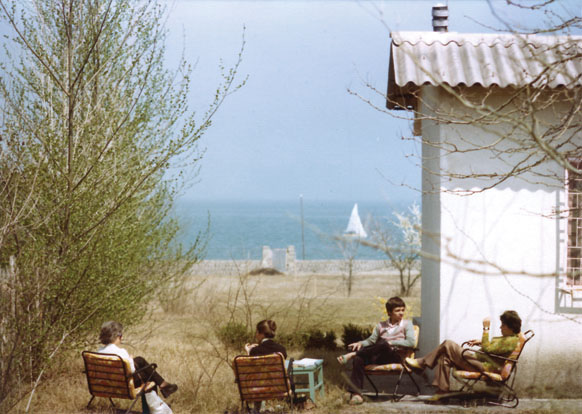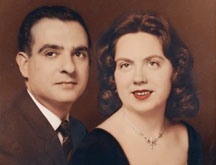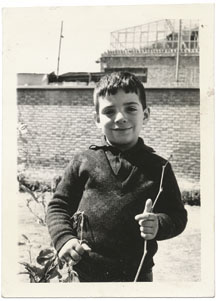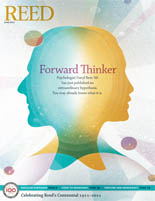
IRIS login | Reed College home Volume 90, No. 2: June 2011
Force Majeure (continued)

The Rejali family spent summers at a villa on the Caspian Sea. Ca. 1974
Photo Courtesy of J. Kazeroni
![]()
If Rejali was more or less buffered from the revolution, it was different later that year, when President Jimmy Carter permitted the Shah to enter the United States, ostensibly for medical treatment. On November 4, 1979, Iranian militants stormed the American Embassy in Tehran and seized 66 hostages, the majority of whom would remain captive for 444 days.

David and Sallie Rejali, 1959

Darius Rejali (c. 1966) in his grandfather’s garden.
Rejali’s Swarthmore friends did not realize that Iran had smoldered since 1953, when America toppled the popular and legally-elected Prime Minister Mohammed Mossadegh by means of a CIA-orchestrated coup, and planted the Shah back on the throne, thereby suffocating Iran’s new democracy movement.
Without this essential background, Americans could not understand the Iranian sense of threat when the Shah showed up in the United States under the protection of President Carter. For once, the eloquent Rejali couldn’t persuade anyone of the facts.
“I felt actually asphyxiated in the United States during the hostage crisis,” he recalls. “I just wanted to get the hell out of Dodge.”
He left the country to do graduate work in Montreal, where he could study with the philosopher Charles Taylor, whom he had read with admiration at Swarthmore.
At McGill, Rejali read Foucault’s Discipline and Punish with an eye on Iran. Iranian society had gone through the kinds of changes that Foucault identifies in Europe, he noted, yet without discarding torture. He browsed through a rich trove of nineteenth-century travelogues and old Qajar texts at McGill’s Institute of Islamic Studies, looking for accounts of punishment.
He’d known since high school that his own family had been implicated in torture. “It was routine for the textbooks used during the Pahlavi dynasty to talk about the violence of the dynasty that preceded them,” he explains. “One book told the story of how a Qajar king ordered thousands of people in town to be blinded, literally removed their eyes.” The story held a special horror for him because that king was his great-grandfather’s great-granduncle.
So while other Iranians of his generation were trying to explain why the revolution went wrong, he was interested in understanding why things remain the same: despite entire revolutions that are “opposed to torture,” torture comes back. “The study of the state wasn’t as interesting to me as the study of punishment as it happened through every aspect of Iranian society,” he says of the work that later became his first book.
Even as the hostage crisis had separated Rejali from American colleagues, now his work separated him from other Iranians. “They wanted me to tell the story of torture in a way that would fit their political biases,” he remembers. As had happened at Swarthmore, his knowledge of history, quite simply, made him lonely.
Meanwhile, in 1984, his own parents, unable to find satisfying work in the United States, actually returned to Iran. When Rejali talks about the several distortions the revolution inflicted on his family, he cites this moment: “They chose family economic security and political insecurity, rather than the reverse.”
When Rejali arrived at Reed in 1989, the political science department consisted of just two other professors: political theorist Peter Steinberger [1977–] and Americanist Steve Kapsch [1974–2005]. Rejali worked around their specialties. “My job, as the middle guy, was to cover everything in between,” he explains. “I’ve been Mr. Philosophy of Social Science, Mr. Social Theory, Mr. Comparative Revolutions.”
This meant that students could take several different courses from him; he calculates that Joseph Orosco ’92 holds the all-time record. “Thirteen courses, if I’m not mistaken.”
Orosco, now associate professor in philosophy and director of the Peace Studies Program at Oregon State University, clearly remembers Rejali’s charisma and sense of style. “He would come to class wearing a shirt with French cuffs, blue jeans, Doc Martens, and a suit jacket, a combination of formal and rowdy that caught people’s imagination.”
Orosco also remembers Rejali in connection with ritual. “He has this sort of alchemist persona. He took pains to make sure his office was structured and decorated in the right way [down to] the type of pen he’d have to do his writing.
“I use that technique now when talking with my own graduate students,” Orosco says. “I talk to them about writing as a sacred ritual: take the work seriously and give it some sort of sacred character.”
Orosco insists Rejali saved him at Reed. “I was floundering around in philosophy, finding my classes dry, until I took his course in political theory. He has a way of engaging students, getting them to talk to each other, to take the texts seriously, and to engage with the world. He has an encyclopedic knowledge of political history and theory, both in Western and Iranian contexts. I just never met anyone who had this range.”
![]()
I met Rejali in the fall of 1999 when author Elinor Langer [creative writing 1985–87] brought brought him to dinner at my apartment. A short and portly Iranian American with an easy, gregarious laugh, Rejali wears his erudition lightly; he is as likely to quote Harry Potter, Lewis Carroll, or Star Trek as Weber, Locke, or Foucault. The following spring, I invited him to my birthday reading of The Gilgamesh, and then to lecture on torture for the human rights class I was teaching for the graduate writing program at Lewis & Clark College.
Now it is hard to remember that just 11 years ago students had to be convinced torture actually existed. Rejali gave a talk, both moving and hopeful, about the techniques different people devise—emotional, physical, and psychological—to survive torture. “Torture teaches you something,” he told my students. “When you look at the victims, it teaches you about the miracle of human resilience.”
Later, in 2002, as our military at Guantánamo began receiving prisoners outfitted in fluorescent orange jumpsuits and turquoise face masks, I asked Rejali whether he thought there was any chance that we were torturing them. He paused, and his careful answer turned out to be prophetic. “I don’t know if we are torturing prisoners,” he said, “but if we are, we will never be able to release them.”
In 1994, Rejali published Torture and Modernity, alerting the Portland Iranian community to the presence of a Persian academic in their midst. Amnesty International activist Goudarz Eghtedari was in Powell’s Books one day, researching material for two campaigns, when his eye fell on Rejali’s book. “So I called him up,” Goudarz recalls, and persuaded Rejali to collaborate on a paper he planned to deliver at the Center for Iranian Research and Analysis (CIRA) conference in Atlanta, and then proposed that Portland host CIRA in 1997. He appointed Rejali conference chair.
To be brought into Portland’s Iranian community by Goudarz Eghtedari is to be plunged into its core: Rejali met all the prominent local Iranian intellectuals. Of Rejali, Goudarz reports with satisfaction, “Now we are best of friends and he has improved his Persian dramatically.”
His Iranian roots are important to Rejali and in 2001, at the age of 42, he made his first trip back. He’d never fulfilled his obligatory military service, and his parents, retired and living in Virginia, were worried about this visit. I remember the moment his going-away dinner turned solemn, as some of us feared he might not make it home.
Rejali wanted to see what President Khatami’s reform movement looked like in the provinces, and his parents traveled with him to Hamadan, Esfahan, and Shiraz, north to the Caspian, and to Mashad and Neyshabur on the Afghan frontier.
“It was a great experience, but the ’rents wouldn’t let me out of their sight,” Rejali says, calling Sallie and David by a term he sometimes uses humorously.
Everyone made it home without incident—just weeks before 9/11.
In the fall of 2001, Rejali was already seven years into Torture and Democracy. In addition to his central thesis about the development of sophisticated “stealth” tortures, the book serves as an encyclopedic reference guide, with tortures organized by category.
“Rather than focus on countries as my subjects,” he explains, “I chose practices and techniques, following them as they snuck across borders.” Calculating that one out of every three countries practices torture, he decided this would be less repetitious.
Research had taken him to the Library of Congress, the Kew Public Record Office in London, where he examined the colonial records of the English, and to Cambodia’s Tuol Sleng Genocide Museum on the site of a notorious prison used by the Khmer Rouge in the late ’70s.
For the most part, though, he relied heavily on a number of clever librarians, especially Sally Loomis [library 1997–2006]. “She loved it. I’d tell her, ‘Well, here’s an obscure hit for you. Do you think you can find this?’ And she’d go out and find it!”
At the Bibliothêque nationale, former student Joel Reville ’97 also located material for him. “I’ve never been to Paris,” Rejali admits. “I like Europe, but I often think I’m just saving it for when I need a wheelchair.”
In his home office, originally the dining room, he had placed a big bronze dragon-shaped candleholder from Indonesia, and the candle was lit whenever he worked. He wrote wearing his old Spanish riding cape and listened to atonal performances of cold, spiritless pieces of modern music that he describes as “incredibly wrenching.”
“Some music that I think very few people would ever want to listen to,” Rejali says. “Because it was connected to the interior scape that I was traveling to, the music was just right. People would actually come into my office when I’d be working at home, and they’d go, ‘What the hell is that?’” And he’d explain it was, say, the Georgian composer Kancheli. “And they’re going, ‘It’s horrible!’ And it’s like, ‘Well, you should see what I’m writing.’”


LATEST COMMENTS
steve-jobs-1976 I knew Steve Jobs when he was on the second floor of Quincy. (Fall...
Utnapishtim - 2 weeks ago
Prof. Mason Drukman [political science 1964–70] This is gold, pure gold. God bless, Prof. Drukman.
puredog - 1 month ago
virginia-davis-1965 Such a good friend & compatriot in the day of Satyricon...
czarchasm - 4 months ago
John Peara Baba 1990 John died of a broken heart from losing his mom and then his...
kodachrome - 7 months ago
Carol Sawyer 1962 Who wrote this obit? I'm writing something about Carol Sawyer...
MsLaurie Pepper - 8 months ago
William W. Wissman MAT 1969 ...and THREE sisters. Sabra, the oldest, Mary, the middle, and...
riclf - 10 months ago